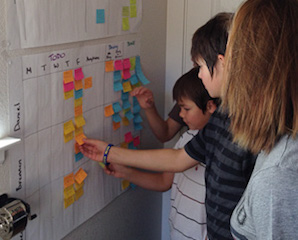 My wife and I have been homeschooling our 3 boys since our oldest, who turns 13 tomorrow, started kindergarten. From the beginning, we’ve tried to apply the Agile, Lean, and accelerated learning principles I use in my work. After 8 years of experimentation, we’ve settled on a system that works really well for our family.
My wife and I have been homeschooling our 3 boys since our oldest, who turns 13 tomorrow, started kindergarten. From the beginning, we’ve tried to apply the Agile, Lean, and accelerated learning principles I use in my work. After 8 years of experimentation, we’ve settled on a system that works really well for our family.
This post isn’t about why we homeschool, what curricula we use, etc. Rather, I’d like to give a glimpse into how we apply some of the principles and practices I use and teach in my classes to a non-software context.

Our school has some natural cadences built in. We spend our summers mountain biking, so the school year naturally runs Fall through Spring. Our core curriculum divides each year into four units, which fit pretty well around holidays and major bike races. Standardized testing happens right before we break for the summer. And with weekends off, there’s a natural weekly cadence through the whole year. Within the week, there’s specific work to do each day. We organize our schoolwork to follow these patterns, planning for years, quarters, weeks, and days at different levels of detail.
Each week, usually on Friday afternoon but sometimes as late as Sunday evening, we reflect on the past week and plan the next. We look at our calendar and learning goals for the upcoming week and fill the queues on our board with the assignments and activities the boys will need to complete.

We assume that the boys want to learn and can self-organize to have the kind of day they want to have. So we’ve set up each week and day as a pull system. We identify and prioritize what needs to be done, indicating constraints as appropriate, and they pull assignments when and how they choose. Some days this requires more encouragement. Other days, my wife and I wake up to find that they’ve completed most of their work so they can spend the afternoon on their bikes.
Here’s a snapshot of the board yesterday morning:

As you can see, it’s more complex than the typical 3-state Scrum story board. We still have Not Started, In Progress, and Done states. But the Not Started state in particular is more nuanced. Some items need to be done on a particular day (e.g. daily musical instrument practice). Other items can be done anytime during the week (e.g. “read chapters X through Y from book Z”). Some items can be done by one child independently (e.g. a math worksheet). Other items need to be done with someone else, a brother or parent or everyone together (e.g. a spelling test or science experiment). Some items can go straight to Done. Most items require a review first. We’ve experimented with a variety of ways to visualize this before finally settling on this board design, which has been stable for almost a year.
(It’s not noted on the board, but we have a policy limiting WIP to 1 item at a time per child. They’re not allowed to multitask.)

Sometimes when I tell people about our approach, they ask questions like, “How do you get the kids to pull their own work?” We’ve mostly found that we don’t have to “get them do it.” Well-designed learning is inherently rewarding. We’re deliberate about the curricula and assignments we choose; if one isn’t working, we change it. We assume the boys are able and motivated to choose how to approach their work, and most of the time, they live up to those expectations.
I tell my agile classes that motivation is often the canary in the coal mine for systemic issues. You may see a change in your own or your team’s motivation before you can name the thing in the system you should keep or change. We see the same pattern in education. When, for example, we observed that our older boys were consistently unmotivated to pull math tasks, rather than pushing them to do those tasks, we had a conversation with them to find out why math wasn’t working. We ended up switching to another curriculum that was more challenging and better-designed. Now, they’re pulling math first most days and even asking for more math assignments.
Of course, we value responding to change over following a plan. This week was going to be a normal school week, but then an opportunity came up to visit Mount Rushmore on Monday and Tuesday, so we reorganized the week to build learning experiences around the trip, and off they went.
Next month is Agile For All’s first alumni conference. We called the conference Humanizing Work because we believe the values and principles that make agile organizations successful are rooted in how we function as humans. Agile approaches conform work to people instead of trying change people to fit work. So, it’s not surprising that the same principles work for our kids’ education. It all comes back to treating people as people.
UPDATE 10/29/14: Check out the latest on how we’re doing Agile Homeschool here: Agile Homeschool Update.
Last updated